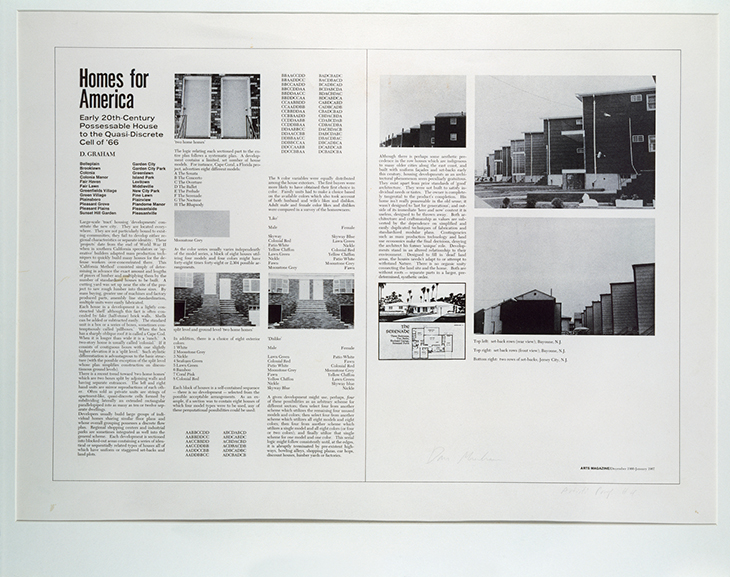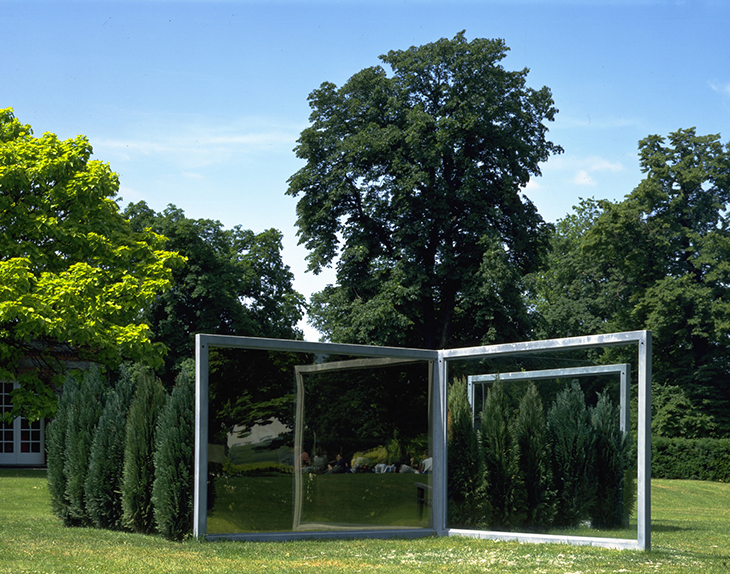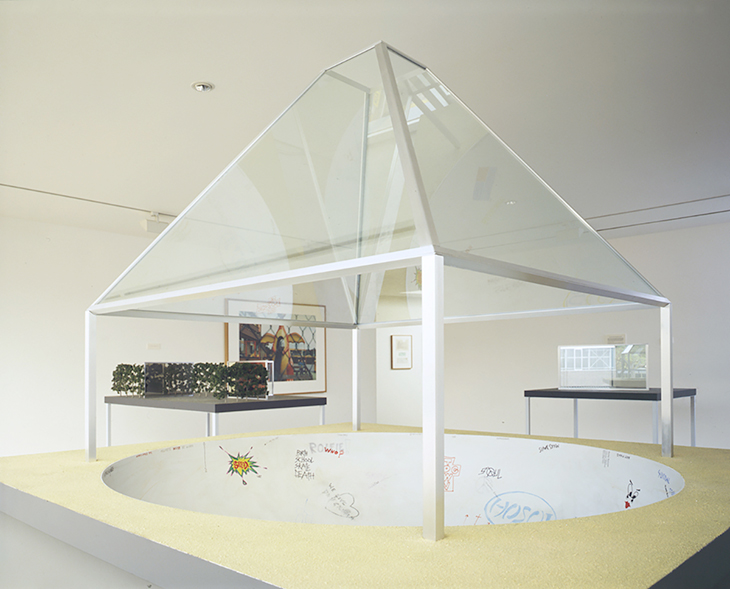Dan Graham, who has died at the age of 79, described himself as a ‘provocateur’ and ‘rebel’. Best known for his glass pavilions, immersive and disorientating sculptural experiences, he considered himself above all an ‘artist writer’, like his peers Donald Judd, Dan Flavin and Robert Smithson. In his early years, the magazine page was his conceptual canvas, and he worked with these publications much as Carl Andre did with bricks or Dan Flavin did fluorescent tubes. In his seminal piece Homes for America (1966–67), for example, he published an illustrated article in Arts magazine featuring his photographs of generic tract houses found in the suburbs of New Jersey, the facades and plans of which parodied Judd’s minimalism. For Detumescence (1966), he took out an advertisement in National Tatler calling for a qualified medic to write him a clinical description of what happens to a man’s penis after climax, which he promised to publish in turn.

Homes for America, Arts Magazine (1966–67), Dan Graham. Courtesy Lisson Gallery; © Dan Graham
When I was editor-in-chief of Modern Painters magazine, then based in New York, I asked him if he would be interested in revisiting such early works on paper. He wanted finally to realise Detumescence, as no-one had replied to his original advertisement, but would do so only if I agreed to drill a hole through the entire run of the magazine, turning every issue into a mobile, disposable glory hole. I wasn’t sure if he was joking – an FU to journalism – as he was incredibly persuasive: we’d be making magazine history with this ‘psycho-sexual-social hole’, it would be a collector’s item, it would fly off the (top) shelves. His brand of subversion was characterised by humorous parody. Needless to say, my publisher showed no interest in negotiating this stunt with our numerous advertisers who would find their galleries and brands hole-punched in this way.
Magazines, Graham said, invaded and infected homes like the pods in the film Invasion of the Body Snatchers (1956). In a 2009 interview, he claimed to barely read art magazines any more because they didn’t have enough writers who were artists. However, he offered my own publication faint praise. ‘I think that Modern Painters, as bad as it is, sometimes has good writing. But it’s very important that artists write about other artists and there isn’t enough of that any more’. He was right: artists, if they had the writerly skill, didn’t like to pass judgement on other artists, perhaps for fear of inviting criticism on themselves (if negative) or out of anxiety of influence (if positive). He had no such hang-ups and was a generous and enthusiastic supporter of countless, often younger artists.

Two way-mirror and hedge labyrinth (1989), Dan Graham. Courtesy Lisson Gallery; © Dan Graham
He kickstarted Kim Gordon of Sonic Youth’s career when he asked her to be part of an all-female trio, CKM, that he was putting together for a performance piece at MIT. Gordon culled her lyrics from Cosmopolitan magazine, creating a Surrealist poetry from advertising copy, which she sang in a nasal, off-key voice. At the time, many of his art-world friends had amateur groups – Mike Kelley performed with the artist Tony Oursler as the Poetics, and Richard Prince and Robert Longo were also in bands. Graham wrote about punk rock from the outset, and one of his most famous pieces is his experimental film Rock my Religion (1984), which drew parallels between ecstatic religious revivalism and rock music and featured original tracks by Sonic Youth and Glenn Branca.
For a while Graham had a column in the Italian architecture and design magazine Abitare, and he wrote about the jokes of his friend Sol Le Witt. LeWitt, who opened Graham’s short-lived John Daniel’s Gallery (founded in 1964), had worked for the architect I.M. Pei and described his early works as ‘jungle gyms for his cats’. It was from LeWitt that Graham got his love of architecture, which he first explored in 1976 in Public Space/ Two Audiences, a pavilion at the Venice Biennale. He divided and altered the space with a two-way mirror, so that visitors could see themselves looking at those on the other side. He intended this confrontational intervention to make critical comment of the zoo-like atmosphere of Biennales by turning people into exhibits.

Model for Skateboard Pavilion (1989), Dan Graham. Courtesy Lisson Gallery; © Dan Graham
Graham made about 60 more ‘pleasure pavilions’, in his description, which refer back to the primitive, rustic hut, but have minimalist steel armatures and distort space with mirrors, elliptical shapes and reflective two-way glass to make a spectacle of surveillance. These palaces of illusion, somewhere between funfair halls of mirrors and a Times Square peepshow, form his impressive, object-based legacy. They are scattered around the world, from Two-Way Mirror Cylinder Inside Cube (1981–91) at the Dia Centre, New York, to Two-Way Mirror Triangle with One-Curved Side (1996) on the remote Lofoten Islands of Norway. He designed one for skateboarders with Kim Gordon and another for children with Jeff Wall, which referred to his mother’s work as an educational psychologist.
Such structures both played with the psychoanalytic notion of the mirror stage, which coincides with the birth of the ego, and also subverted 1970s and ’80s corporate architecture. They have, in turn, influenced architects such as SANAA, whose annexe for the Toledo Museum of Art in Ohio used layers of curved glass, and Herzog & de Meuron, who quoted Graham in the rippling forms of their crystalline Elbphilharmonie in Hamburg. Graham continued to write, publishing his encyclopaedic and witty essays – on astrology, music, Dean Martin, 18th-century gardens and amusement parks – in Rock my Religion, 1965–1990 and Two-Way Mirror Power: Selected Writings by Dan Graham on His Art (1999). ‘I actually think of myself as more of a writer than an artist,’ Graham said in an oral history for MOMA, ‘and I don’t think of myself as an architect, but my work is always hybrid.’

Dan Graham regarded himself as a rebel – and the art world could do with more of his attitude
Dan Graham photographed by Sebastian Kim in 2017. Courtesy Lisson Gallery; © Dan Graham
Share
Dan Graham, who has died at the age of 79, described himself as a ‘provocateur’ and ‘rebel’. Best known for his glass pavilions, immersive and disorientating sculptural experiences, he considered himself above all an ‘artist writer’, like his peers Donald Judd, Dan Flavin and Robert Smithson. In his early years, the magazine page was his conceptual canvas, and he worked with these publications much as Carl Andre did with bricks or Dan Flavin did fluorescent tubes. In his seminal piece Homes for America (1966–67), for example, he published an illustrated article in Arts magazine featuring his photographs of generic tract houses found in the suburbs of New Jersey, the facades and plans of which parodied Judd’s minimalism. For Detumescence (1966), he took out an advertisement in National Tatler calling for a qualified medic to write him a clinical description of what happens to a man’s penis after climax, which he promised to publish in turn.
Homes for America, Arts Magazine (1966–67), Dan Graham. Courtesy Lisson Gallery; © Dan Graham
When I was editor-in-chief of Modern Painters magazine, then based in New York, I asked him if he would be interested in revisiting such early works on paper. He wanted finally to realise Detumescence, as no-one had replied to his original advertisement, but would do so only if I agreed to drill a hole through the entire run of the magazine, turning every issue into a mobile, disposable glory hole. I wasn’t sure if he was joking – an FU to journalism – as he was incredibly persuasive: we’d be making magazine history with this ‘psycho-sexual-social hole’, it would be a collector’s item, it would fly off the (top) shelves. His brand of subversion was characterised by humorous parody. Needless to say, my publisher showed no interest in negotiating this stunt with our numerous advertisers who would find their galleries and brands hole-punched in this way.
Magazines, Graham said, invaded and infected homes like the pods in the film Invasion of the Body Snatchers (1956). In a 2009 interview, he claimed to barely read art magazines any more because they didn’t have enough writers who were artists. However, he offered my own publication faint praise. ‘I think that Modern Painters, as bad as it is, sometimes has good writing. But it’s very important that artists write about other artists and there isn’t enough of that any more’. He was right: artists, if they had the writerly skill, didn’t like to pass judgement on other artists, perhaps for fear of inviting criticism on themselves (if negative) or out of anxiety of influence (if positive). He had no such hang-ups and was a generous and enthusiastic supporter of countless, often younger artists.
Two way-mirror and hedge labyrinth (1989), Dan Graham. Courtesy Lisson Gallery; © Dan Graham
He kickstarted Kim Gordon of Sonic Youth’s career when he asked her to be part of an all-female trio, CKM, that he was putting together for a performance piece at MIT. Gordon culled her lyrics from Cosmopolitan magazine, creating a Surrealist poetry from advertising copy, which she sang in a nasal, off-key voice. At the time, many of his art-world friends had amateur groups – Mike Kelley performed with the artist Tony Oursler as the Poetics, and Richard Prince and Robert Longo were also in bands. Graham wrote about punk rock from the outset, and one of his most famous pieces is his experimental film Rock my Religion (1984), which drew parallels between ecstatic religious revivalism and rock music and featured original tracks by Sonic Youth and Glenn Branca.
For a while Graham had a column in the Italian architecture and design magazine Abitare, and he wrote about the jokes of his friend Sol Le Witt. LeWitt, who opened Graham’s short-lived John Daniel’s Gallery (founded in 1964), had worked for the architect I.M. Pei and described his early works as ‘jungle gyms for his cats’. It was from LeWitt that Graham got his love of architecture, which he first explored in 1976 in Public Space/ Two Audiences, a pavilion at the Venice Biennale. He divided and altered the space with a two-way mirror, so that visitors could see themselves looking at those on the other side. He intended this confrontational intervention to make critical comment of the zoo-like atmosphere of Biennales by turning people into exhibits.
Model for Skateboard Pavilion (1989), Dan Graham. Courtesy Lisson Gallery; © Dan Graham
Graham made about 60 more ‘pleasure pavilions’, in his description, which refer back to the primitive, rustic hut, but have minimalist steel armatures and distort space with mirrors, elliptical shapes and reflective two-way glass to make a spectacle of surveillance. These palaces of illusion, somewhere between funfair halls of mirrors and a Times Square peepshow, form his impressive, object-based legacy. They are scattered around the world, from Two-Way Mirror Cylinder Inside Cube (1981–91) at the Dia Centre, New York, to Two-Way Mirror Triangle with One-Curved Side (1996) on the remote Lofoten Islands of Norway. He designed one for skateboarders with Kim Gordon and another for children with Jeff Wall, which referred to his mother’s work as an educational psychologist.
Such structures both played with the psychoanalytic notion of the mirror stage, which coincides with the birth of the ego, and also subverted 1970s and ’80s corporate architecture. They have, in turn, influenced architects such as SANAA, whose annexe for the Toledo Museum of Art in Ohio used layers of curved glass, and Herzog & de Meuron, who quoted Graham in the rippling forms of their crystalline Elbphilharmonie in Hamburg. Graham continued to write, publishing his encyclopaedic and witty essays – on astrology, music, Dean Martin, 18th-century gardens and amusement parks – in Rock my Religion, 1965–1990 and Two-Way Mirror Power: Selected Writings by Dan Graham on His Art (1999). ‘I actually think of myself as more of a writer than an artist,’ Graham said in an oral history for MOMA, ‘and I don’t think of myself as an architect, but my work is always hybrid.’
Unlimited access from just $16 every 3 months
Subscribe to get unlimited and exclusive access to the top art stories, interviews and exhibition reviews.
Share
Recommended for you
Conceptual art’s all talk – and that’s a problem for curators
Tate’s ‘Conceptual art in Britain’ show is remarkably dense and text heavy, but then how could it be anything else?
‘He taught by example’ – a tribute to John Baldessari (1931–2020)
One of the inventors of conceptual art, and a towering figure on the West Coast scene, he was also a dedicated mentor to his students
‘It is what it is.’ Dan Flavin’s iconic light fittings in the Ikon Gallery
Flavin’s fluorescent light pieces continue to transform the spaces in which they are installed. But time is changing how we see the pieces, too